Congress sends highway conduit bill into the slow lane
![By User Minesweeper on en.wikipedia (Minesweeper) [GFDL (https://www.gnu.org/copyleft/fdl.html) or CC-BY-SA-3.0 (https://creativecommons.org/licenses/by-sa/3.0/)], via Wikimedia Commons](https://www.tellusventure.com/images/2015/11/eastshore_traffic.jpg)
Broadband conduit won’t be getting a fast track into federal highway projects. A bill sponsored by Silicon Valley congresswoman Anna Eshoo would require broadband considerations, and conduit in particular, be included in the planning that states do for federally funded highway construction.
The easy way to get it done would have been to include the language in this years’ highway funding bill, which is a must pass piece of legislation. Eschoo tried to do that, but was rebuffed.… More

![By National Institute for Occupational Safety and Health (NIOSH) from USA (Highway construction workers using concrete saws) [Public domain], via Wikimedia Commons](https://www.tellusventure.com/images/2015/11/highway_construction_workers_using_concrete_saws.jpg)






